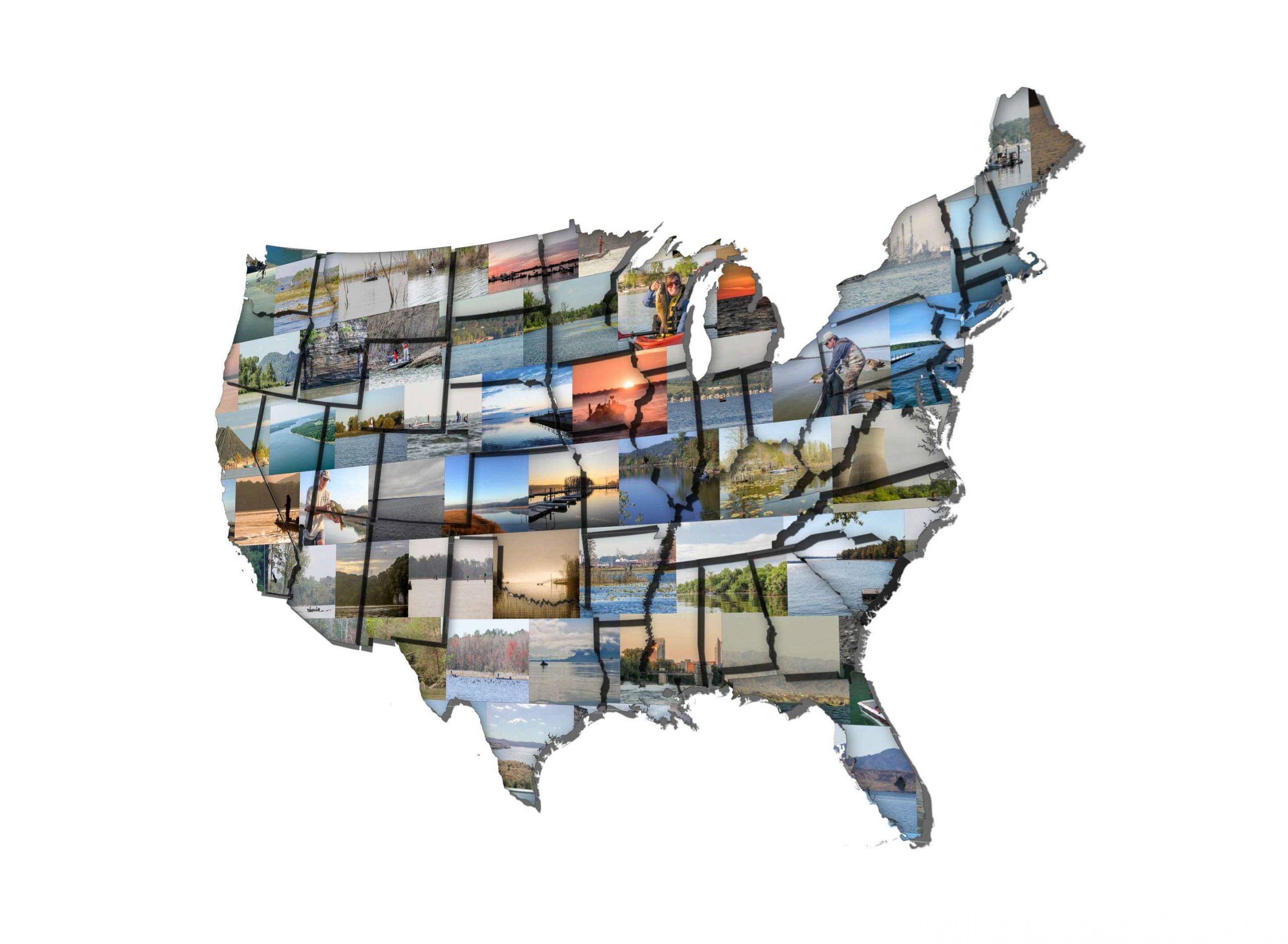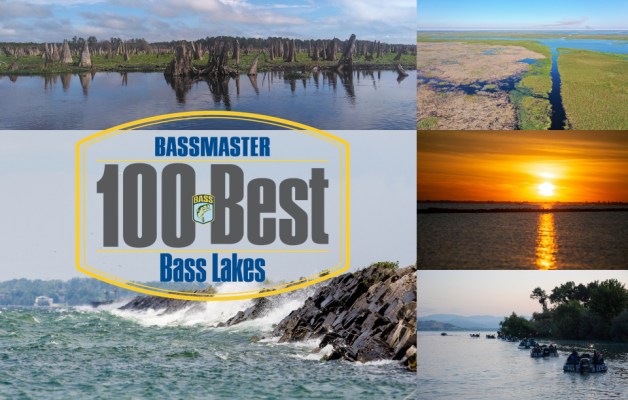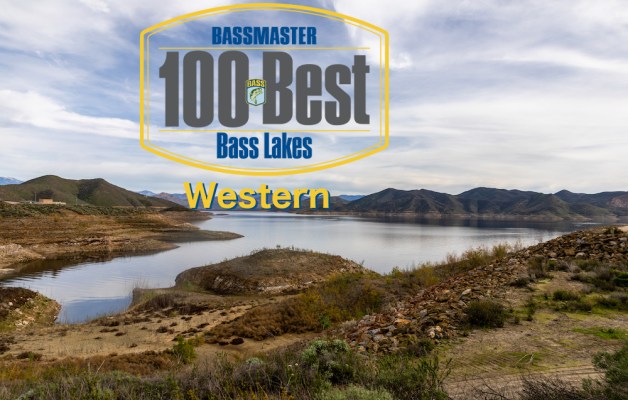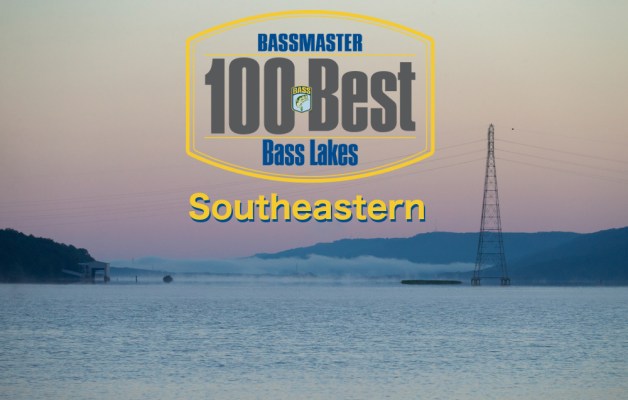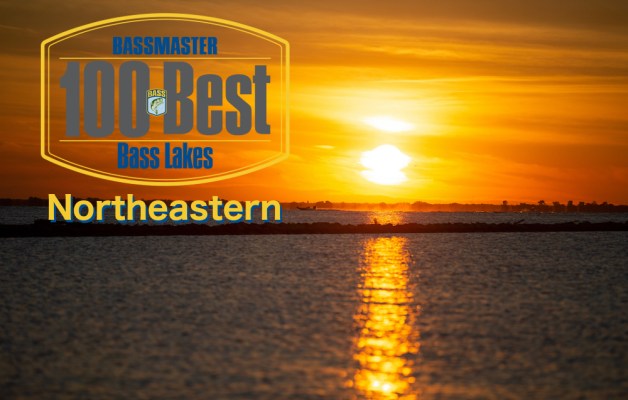
![25. Sand Hollow Reservoir, Utah [1,300 acres] Being relatively deep at the north end and shallow to the south, youâll have your choice of fishing methods here. This is a largemouth hotspot where 10 to 30 desert bass per day is routine â most 1 to 2 pounds. But there are bass over 5 pounds, too. The champs at an Ultimate Bass Team Tour contest in March weighed 21.41.](http://www.bassmaster.com/wp-content/uploads/2016/08/01_bbl_w_25_sand_hollow_reservoir_ut_sandhollow052208_007-2-scaled.jpg)
![24. Apache Lake, Arizona [2,568 acres] The surrounding Superstition Wildernessâ wildlife, including bighorn sheep and eagles, make it tough to concentrate on fishing here. But Apacheâs secluded coves offer something more entertaining â lots of bass. Donât expect to catch a trophy, but 6- to 7-pound fish are realistic. The winning boater and co-angler at an Arizona B.A.S.S. Nation qualifier in February had 6.19 and 7.62 kickers, respectively.](http://www.bassmaster.com/wp-content/uploads/2016/08/02_bbl_w_24_apache_lake_az_scenic_apache_lk-scaled.jpg)
![23. Flaming Gorge Reservoir, Utah/Wyoming [42,020 acres] This is smallmouth country, but a short growing season means few trophies. What you will find are 50- to 100-fish days. Bigger fish tend to be on the Wyoming side, where their state record was caught. Stick to the Utah side for numbers. There had been no contests at the time of this writing, but when asked about opportunities the Utah Division of Wildlife Resources ranked this their stateâs No. 2 fishery.](http://www.bassmaster.com/wp-content/uploads/2016/08/03_bbl_w_23_flaming_gorge_reservoir_ut_wy_flaming_gorge_utah_23-9-2014_12-49-13-scaled.jpg)
![22. Shasta Lake, California [30,000 acres] Hit hard by the drought, this Sacramento River impoundment needed better than average precipitation to make this list again. And thanks to more than 60 inches of rain and above normal snowpack on Mt. Shasta it remains a top destination. Big spotted bass dominate. It took an 11-pound average to make the cut at a February FLW event, with 40-7 taking the win. Big fish was a giant 7-2 spot.](http://www.bassmaster.com/wp-content/uploads/2016/08/04_bbl_w_22_shasta_lake_ca_lake_shasta.triddle.jpg)
![21. Lake Powell, Utah/Arizona [108,335 acres] Extra time is needed here because youâll spend as much time taking in the scenery as fishing. But those same canyons and rocky terrain that catch your eye provide this Colorado River impoundment with great fish habitat. Utahâs record largemouth came from here, but Powell isnât a trophy fishery. Itâs a 3-pound average numbers game. It took a 3-day total of 46.38 to win a Utah B.A.S.S. Nation team qualifier in March.](http://www.bassmaster.com/wp-content/uploads/2016/08/05_bbl_w_21_lakepowell_100_0358.jpg)
![20. Lake Mead, Nevada/Arizona [158,080 acres] Impacts from multiple years of drought in the West will be felt long after the return of wet conditions. But Jon Sjoberg, with the Nevada Department of Wildlife, says that isnât the case here. âLake Mead still provides excellent largemouth and smallmouth fishing.â It took a 16-plus-pound average to win the 3-day Academy Sports + Outdoors B.A.S.S. Nation Western Regional presented by Magellan here in early April.](http://www.bassmaster.com/wp-content/uploads/2016/08/06_bbl_w_20_lake_mead_nv_az_mead_mg_0460-scaled.jpg)
![19. Brownlee Reservoir, Idaho/Oregon [15,000 acres] Although some call Brownlee the most heavily fished body of water in either state, this Snake River hydro impoundment provides above average action. And despite being in Hells Canyon, itâs heaven to anglers targeting smallmouth. A Snake River Bassmasters event in March was won with 17.30 â all brown.](http://www.bassmaster.com/wp-content/uploads/2016/08/07_bbl_w_19_brownlee_reservoir_id_or_brownlee_smbtagging01-scaled.jpg)
![18. Columbia River, Oregon/Washington [191 miles from Portland to McNary Dam] Forty-five miles of free-flowing river from Portland to Bonneville Dam, and 146 miles of pooled reaches upstream to McNary, provide some of the best smallmouth fishing in the west. The top four teams at a Columbia River Bassmasters tournament out of Celilo Park in April had 18-plus pounds. The big bass was 5-8.](http://www.bassmaster.com/wp-content/uploads/2016/08/08_bbl_w_18_columbia_river_or_wa_columbiagorge_capehorn.jpg)
![17. Banks Lake, Washington [26,886 acres] Bass fishing in the Pacific Northwest can be hit or miss, but Banks is pretty close to guaranteed action. Although the state record largemouth was caught here, 1- to 2-pound smallmouth outnumber bigger fish by a lot. Tournament anglers have to work through 30-50 bass a day to catch the 3-and 4-pounders needed to win â not that anyone is complaining. A Northwest Bass contest, held April 9, was won with 20.20 pounds.](http://www.bassmaster.com/wp-content/uploads/2016/08/09_bbl_w_17_banks_lakewa_banks_lake_1.jpg)
![16. Lake Mohave, Nevada/Arizona [26,500 acres] Often overshadowed by much bigger Lake Mead upstream, this relatively shallow, narrow reservoir is a structure anglerâs dream. And because so many come for the world-class stripers, the quality largemouths that live here tend to see less pressure â although word is, they can still be tough to catch due to lots of forage. It took 21.14 to win an Ultimate Bass Team Tour contest here in March.](http://www.bassmaster.com/wp-content/uploads/2016/08/10_bbl_w_16_lake_mohave_nv_az_mohave_3_habitat.jpg)
![15. C.J. Strike Reservoir, Idaho [7,500 acres] High desert lakes to the north donât often grow big bass thanks to shorter growing seasons. This Snake River impoundment is an exception. Smallmouth outnumber largemouth during most derbies by 4:1, with anglers that find the green variety usually winning. The top two finishers at an Idaho Bass Federation event in April weighed 22.54 and 21.31 â nine of their 10 fish were largemouth.](http://www.bassmaster.com/wp-content/uploads/2016/08/11_bbl_w_15_c.j._strike_rservoir_id_cj_strike.jpg)
![14. Roosevelt Lake, Arizona [21,493 acres] Properly called Theodore Roosevelt Lake, this place had been known for trophies â largemouth to 14 pounds and the 7.06 state record smallmouth came from here. Then things went south! But thankfully, new management practices have returned this Salt River reservoir to the top of the charts. A March two-day Wild West Bass Pro-Am was won with 40.73 pounds. Big fish was a 10.61 largemouth.](http://www.bassmaster.com/wp-content/uploads/2016/08/12_bbl_w_14_roosevelt_lake_az_lk_roosevelt.jpg)
![13. Lake Coeur dâAlene, Idaho [25,000 acres] You donât hear a lot about natural lakes when discussing fishing in the West, but this one is talked about often when quality bass are the topic. Coeur dâAlene is glacial, but even with its cooler waters it typically takes greater than 20 pounds to win here. An American Bass contest in April was won with 21.64, with the seven fish between 6 and almost 9 pounds, showing how special this place is.](http://www.bassmaster.com/wp-content/uploads/2016/08/13_bbl_w_13_lake_coeur_dalene_id_lakecoeurdalenebig.jpg)
![12. Potholes Reservoir, Washington [14,281 acres] Quality largemouth outnumber smallmouth by almost six to one, but this gem is a bass anglerâs paradise for both. Vegetation and over 1,000 submerged islands offer largemouth habitat on the north and west sides, while rockpiles to the east and south are perfect for smallmouth. The top seven teams at an April American Bass contest weighed 20 or more pounds, with the top team winning with 23.13.](http://www.bassmaster.com/wp-content/uploads/2016/08/14_bbl_w_12_potholes_reservoir_wa_potholes_reservoir_2.jpg)
![11. Snake River, Idaho/Oregon [100 mile Hells Canyon Wilderness reach] Catching smallmouth in a reservoir can be exhilarating, but in a river the experience elevates to another level. Maybe the best-kept secret in the world of bass fishing is this stretch of the Snake, where 70-plus smallmouth per day isnât the peak but the average. During an April jet boat trip, Jess Baugh of Mountain River Outfitters says four clients caught 30 bass each in an hour from a single hole.](http://www.bassmaster.com/wp-content/uploads/2016/08/15_bbl_w_11_snake_river_id_or_snake_river1-scaled.jpg)
![10. Saguaro Lake, Arizona [1,267 acres] With its towering red-orange cliffs, this westernmost reservoir on the Salt River may be Arizonaâs most underutilized bass fishery. There are plenty of big bass here, and it often takes more than 20 pounds to win a tournament. At a Monterey Bass Co. senior teams contest in January, the winners weighed a 23.43-pound limit that included an 8.22 big fish.](http://www.bassmaster.com/wp-content/uploads/2016/08/16_bbl_w_10_saguaro_lake_az_saguaro_at_dusk-scaled.jpg)
![9. Don Pedro Reservoir, California [13,000 acres] Water levels fluctuate considerably at this impoundment located at the Sierra Nevada foothills. And so does the fishing. But trophy largemouth are the attraction, and although fish numbers are not as high as in other regional waters, a real chance at a bass in the teens is inviting â the lake record, set in 2003, is 18-9. An April Future Pro Tour team event was won with 19.84 pounds, for only four fish!](http://www.bassmaster.com/wp-content/uploads/2016/08/17bbl_w_09_don_pedro_reservoir_ca_tuolumne_river-south_fork_3.jpg)
![8. Lake Washington, Washington [21,747 acres] This is Washingtonâs second largest natural lake, and its long, narrow shape creates more bass-holding habitat than most waters in the region. Relatively close to Seattle and fed by the Sammamish and Cedar rivers, many say itâs one of the stateâs most productive lakes for both largemouth and smallmouth. It took 24.74 to win this yearâs American Bass Washington West regional opener.](http://www.bassmaster.com/wp-content/uploads/2016/08/18_bbl_w_08_lake_washington_wa_lk_washington_aerial.jpg)
![7. Tenmile Lake, Oregon [1,626 acres] Actually two lakes connected by a canal, Tenmile was historically a cold water fishery. After attempts to kill off non-Ânative warmwater species failed in the late â60s, this coastal destination became and remains Oregonâs premier largemouth factory with 5- to 7-pound bass common. There are some even bigger. It took 25.23 pounds to win an American Bass tournament in March. Big fish at that one was 7.35.](http://www.bassmaster.com/wp-content/uploads/2016/08/19_bbl_w_07_tenmile_lake_or_15547823271_28c4100e4e_o.jpg)
![6. Lake Casitas, California [1,100 acres] Southern California anglers understand that heavy trout plants often result in huge bass. When the state placed a moratorium on stocking in January 2010, the sighs were many. But good news! That ban was lifted last year and the results are already being felt. An American Bass tournament held here in February was won with 28.71, with the big fish weighing in at 9 pounds.](http://www.bassmaster.com/wp-content/uploads/2016/08/20_bbl_w_06_lake_casitasca_californialakecasitas.jpg)
![5. Dworshak Reservoir, Idaho [17,090 acres] One local guide calls this âthe least used body of water in the state.â Thatâs surprising considering the last two record smallmouth came from here. Martin Koenig, Sportfishing Program Coordinator for Idaho Fish and Game, says Dworshak is his pick for the stateâs top trophy fishery. His claim was supported on April 4 when Quinten Kelly missed claiming a new state title by ounces with a 9.5-pound bruiser.](http://www.bassmaster.com/wp-content/uploads/2016/08/21_bbl_w_05_dwarshak_reservoir_id_dworshak_ibm_eight_4lb._average_sm.jpg)
![4. Lake Havasu, Arizona/California [19,300 acres] Year-round sun and crystal-clear waters make this desert oasis a popular tourist destination. Ideal growing conditions, steady water levels and lots of big bass are why anglers come to this Colorado River impoundment. Almost 18 pounds per day, anchored by a 5 1/2-pound or bigger fish, were needed to finish in the money at a National Bass West 2-day Open held in March.](http://www.bassmaster.com/wp-content/uploads/2016/08/22_bbl_w_04_lake_havasu_az_ca_150507lhaz_0354-scaled.jpg)
![3. Lake Berryessa, California [20,700 acres] This Bay Area gem was built to supply Solano County agriculture and residents with water, so levels fluctuate dramatically regardless of excessive rainfall or drought. But the largemouth, smallmouth and spotted bass that call this place home deal with the changing conditions and thrive. On April 2 it took 39.90, which included a 9.11-pound kicker, to win a Wild West Bass Trail team event.](http://www.bassmaster.com/wp-content/uploads/2016/08/23_bbl_w_03_lakeberryessaca_lake_berryessa_aw-scaled.jpg)
![2. Sacramento-San Joaquin Delta, California
[1,100 square miles] A labyrinth of tule-lined rivers, sloughs and vegetation-choked flooded Âislands make this one of the nationâs premier largemouth fisheries. It took more than 25 pounds to win 60 percent of the January-April tournaments we surveyed. And there were five 30-pound bags at an American Bass contest in March. Big fish prizes during spring tournaments typically go to anglers with a bass near or just over 10 pounds.](http://www.bassmaster.com/wp-content/uploads/2016/08/24_bbl_w_02_sacramento-san_joaquin_delta_ca_150430srca0137-scaled.jpg)
[1,100 square miles] A labyrinth of tule-lined rivers, sloughs and vegetation-choked flooded Âislands make this one of the nationâs premier largemouth fisheries. It took more than 25 pounds to win 60 percent of the January-April tournaments we surveyed. And there were five 30-pound bags at an American Bass contest in March. Big fish prizes during spring tournaments typically go to anglers with a bass near or just over 10 pounds.
![1. Clear Lake, California
[43,785 acres] Despite above-average fishing pressure this trophy producer doesnât stop pumping out quality bass. And itâs even better in 2016. Charles Almassey landed and released a 16.3-pound largemouth, the biggest caught here since 1990, in March. A three-day WON tournament during the same month saw 31 bass between 7 and 11 pounds come to the scales. Guides also reported clients regularly catching 30-plus pound limits.](http://www.bassmaster.com/wp-content/uploads/2016/08/25_bbl_w_01_clear_lake_ca_dsc_1625-scaled.jpg)
[43,785 acres] Despite above-average fishing pressure this trophy producer doesnât stop pumping out quality bass. And itâs even better in 2016. Charles Almassey landed and released a 16.3-pound largemouth, the biggest caught here since 1990, in March. A three-day WON tournament during the same month saw 31 bass between 7 and 11 pounds come to the scales. Guides also reported clients regularly catching 30-plus pound limits.
